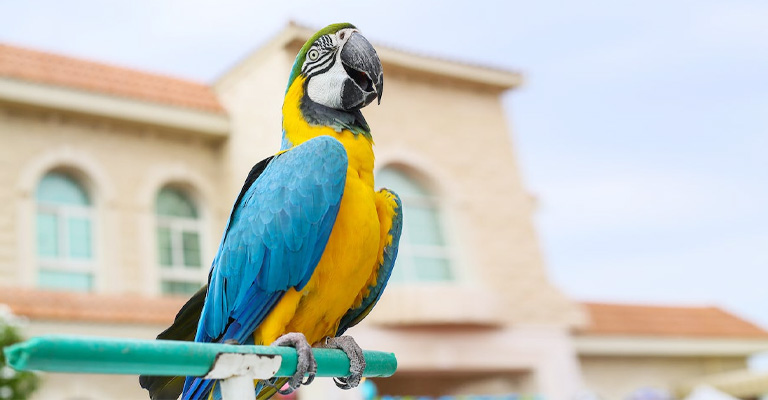The charm of pet birds is undeniable – their vibrant plumage, melodious songs, and endearing personalities make them cherished companions. However, amidst the joy they bring, a question looms: Do pet birds carry diseases?
This query arises from a legitimate concern for both the health of these feathered friends and that of their human caretakers.
In this exploration, we delve into the multifaceted world of pet birds and their potential as disease carriers.
We aim to shed light on the realities of this matter, acknowledging that while pet birds can indeed carry diseases, with proper care and hygiene, the risks can be minimized.
By understanding the nuances of bird-related diseases, we empower ourselves as responsible pet owners to provide a safe and nurturing environment for our avian companions.

Do Pet Birds Carry Diseases?
Yes, pet birds can carry diseases, some of which may potentially affect humans. It’s important to be aware of these diseases and take preventive measures to protect both your feathered friends and yourself.
Here are some diseases that pet birds can carry, along with brief descriptions of each:
Psittacosis (Parrot Fever)
Psittacosis is a bacterial infection caused by Chlamydia psittaci. It can be transmitted to humans through inhalation of contaminated dust or droppings. Symptoms in birds and humans include respiratory issues, fever, and fatigue.
Avian Influenza (Bird Flu)
Avian influenza is caused by influenza A viruses and can affect both wild and domesticated birds. While the risk of transmission to humans is generally low, certain strains have caused outbreaks with severe consequences.
Salmonellosis
Salmonella bacteria can be found in the feces of many birds. Infection can occur through contact with contaminated surfaces or bird droppings. Symptoms in humans include diarrhea, vomiting, and fever.
Aspergillosis
This fungal infection, caused by Aspergillus species, can affect a bird’s respiratory system. It can be transmitted to humans through inhalation of spores, causing respiratory problems and fever.
Candidiasis (Thrush)
Candida yeast infections can affect a bird’s digestive system. In humans, it can lead to oral or genital infections if transmitted through contact with contaminated food or surfaces.
Giardiasis
Giardia is a protozoan parasite found in the feces of infected birds. It can cause gastrointestinal problems in birds and is transmissible to humans through contaminated water or surfaces.
Polyoma Virus
This virus primarily affects young parrots and can lead to sudden death or severe illness. Transmission to humans is rare but not entirely impossible.
Beak and Feather Disease (PBFD)
PBFD is a viral disease affecting the feathers and beaks of birds. It is highly contagious among birds but not transmissible to humans.
Newcastle Disease
Newcastle disease is a contagious viral infection that affects various bird species, including poultry and pet birds. It poses minimal risk to humans but can be devastating to bird populations.
Preventing disease transmission is crucial. Regular veterinary check-ups, proper hygiene, and avoiding direct contact with bird droppings can help reduce the risk of disease in both pet birds and their human caregivers.
How Do I Diagnose My Birds If My Bird Has Any Disease?

Birds are very good at hiding their illness, so it is important to be observant and attentive to their behavior and appearance.
Here are the diagnosis methods that you can use to check your birds’ health:
Observe Their Droppings
One of the easiest and most reliable ways to diagnose your birds is to look at their droppings. Healthy droppings consist of three parts: a dark solid part (feces), a white part (urine), and a clear liquid part (urine).
If your birds have abnormal droppings, such as watery, bloody, green, or yellow, it may indicate a problem with their digestive system, liver, kidneys, or infection.
Check Their Weight
Another way to diagnose your birds is to check their weight regularly. You can use a digital scale or a kitchen scale to weigh your birds in grams.
Healthy birds have a stable weight that corresponds to their species, age, and diet. If your birds lose or gain weight suddenly or excessively, it may indicate a problem with their metabolism, nutrition, or disease.
Examine Their Feathers
A third way to diagnose your birds is to examine their feathers. Healthy feathers are smooth, shiny, and colorful.
They also molt regularly and symmetrically. If your birds have abnormal feathers, such as dull, brittle, or plucked, it may indicate a problem with their skin, hormones, or stress.
Look At Their Eyes
A fourth way to diagnose your birds is to look at their eyes. Healthy eyes are bright, clear, and alert. They also blink normally and have no discharge or swelling.
If your birds have abnormal eyes, such as cloudy, red, or sunken, it may indicate a problem with their vision, infection, or dehydration.
Listen To Their Breathing
A fifth way to diagnose your birds is to listen to their breathing. Healthy breathing is quiet, regular, and effortless.
They also have no sneezing or coughing. If your birds have abnormal breathing, such as noisy, rapid, or labored, it may indicate a problem with their respiratory system, heart, or air sacs.
Feel Their Crop
A sixth way to diagnose your birds is to feel their crop. The crop is a pouch in the neck that stores food before it enters the stomach.
Healthy crops are soft and empty in the morning and full after eating. They also empty within 12 hours after eating.
If your birds have abnormal crops, such as hard, swollen, or slow-emptying, it may indicate a problem with their digestion, infection, or blockage.
Watch Their Behavior
A seventh way to diagnose your birds is to watch their behavior. Healthy behavior is active, playful, and social.
They also eat and drink normally and have no signs of pain or discomfort. If your birds have abnormal behavior, such as lethargy, aggression, or depression, it may indicate a problem with their mental health, environmental stressors, or disease.
Take Their Temperature
An eighth way to diagnose your birds is to take their temperature. You can use a digital thermometer or an infrared thermometer to measure the temperature of your birds’ cloaca (the opening where they excrete waste).
Healthy temperature ranges from 38°C to 42°C depending on the species of the bird. If your birds have abnormal temperatures, such as too high or too low, it may indicate a problem with their immune system, inflammation, or infection.
Consult A Veterinarian
The ninth and most important way to diagnose your birds is to consult a veterinarian who specializes in avian medicine.
A veterinarian can perform more advanced and accurate tests, such as blood tests, x-rays, or biopsies, to diagnose your birds’ condition and provide appropriate treatment and care.
You should take your birds to a veterinarian at least once a year for a routine check-up or whenever you notice any signs of illness or injury in your birds.
What To Do For My Birds To Be Disease-Free?

Ensuring the health and well-being of your pet birds is paramount, and keeping them disease-free is a crucial part of responsible bird ownership.
Here are some techniques to help you achieve this goal:
Regular Veterinary Check-Ups
Schedule routine check-ups with an avian veterinarian. Regular examinations can help detect and address health issues early, preventing the spread of diseases.
Quarantine New Birds
When introducing new birds to your flock, quarantine them in a separate space for at least 30 days. This helps prevent the potential transmission of diseases to your existing birds.
Hygiene and Cleanliness
Maintain a clean environment in the birdcage and surrounding area. Regularly clean cages, perches, toys, and dishes to prevent the buildup of bacteria and parasites.
Isolation of Sick Birds
If a bird shows signs of illness, promptly isolate it from the rest of the flock. This prevents potential disease spread and allows for focused care.
Proper Nutrition
Ensure your birds receive a balanced diet with high-quality food and fresh water. A well-nourished bird is more resistant to disease.
Avoid Overcrowding
Provide adequate space for your birds to reduce stress and minimize the risk of disease transmission in cramped conditions.
Prevent Contact with Wild Birds
Avoid exposing your birds to wild birds or their droppings, as they can carry diseases that may affect your pets.
Quarantine New Supplies
Quarantine new toys, perches, or accessories before introducing them to your birds. This helps prevent the introduction of pathogens from outside sources.
Educate Yourself
Stay informed about common avian diseases, their symptoms, and preventive measures. Knowledge is a powerful tool in protecting your birds’ health.
By following these techniques and practicing responsible bird ownership, you can create a safer and healthier environment for your feathered companions, reducing the risk of diseases and ensuring their well-being.
Regular veterinary care and preventive measures are essential steps in keeping your birds disease-free.
FAQ
Yes, pet birds can carry diseases like avian influenza, psittacosis, and salmonellosis that can potentially affect humans. However, proper hygiene and regular veterinary care can significantly reduce the risk of transmission.
Practice good hygiene, clean cages and accessories regularly, avoid contact with wild birds, and schedule routine veterinary check-ups for your pet birds.
While all birds can potentially carry diseases, the risk varies by species. Some birds, like parrots and pigeons, have a higher likelihood of carrying zoonotic diseases that can affect humans.
Yes, some diseases may not show visible symptoms in birds but can still be transmitted to humans. Regular vet visits, proper hygiene, and preventive measures are crucial.
It’s possible, especially if other pets come into close contact with your bird’s feces or respiratory secretions. Keep different species of pets separate to minimize the risk of disease transmission.
Conclusion
In the grand tapestry of pet ownership, the question of whether pet birds carry diseases receives a nuanced answer.
Yes, pet birds can potentially harbor diseases, just as any animal can carry pathogens.
However, this should not deter us from the joys of avian companionship. Instead, it underscores the importance of responsible bird ownership.
By adhering to proper hygiene, regular veterinary care, and preventive measures, we can significantly reduce the risk of disease transmission between pet birds and their human caretakers.
This knowledge equips us to provide a safe and loving environment in which our feathered friends can thrive, allowing us to savor the beauty of avian companionship without undue concern for disease transmission.